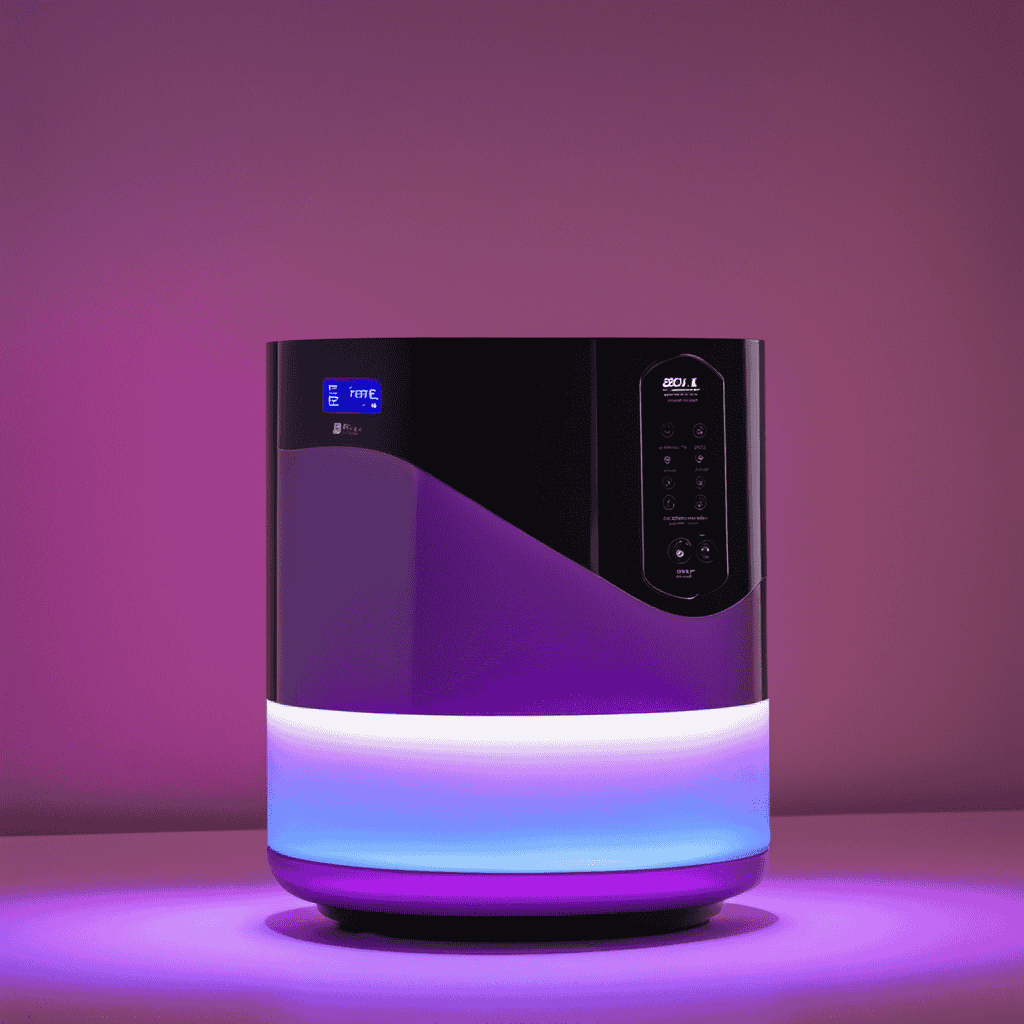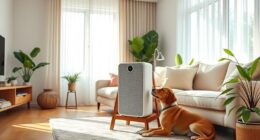As someone who loves technology, I have always been amazed by the capabilities of USB devices. But did you know that you can now power an air purifier with a USB? Yes, it’s true!
In this article, we’ll explore the ins and outs of how USB-powered air purifiers work. From understanding the technology behind air purification to the components that make it all possible, we’ll dive deep into this innovative and convenient solution.
So, let’s plug in and discover the benefits of USB-powered air purifiers together!
Key Takeaways
- USB power provides convenience and versatility for air purifiers.
- Air purifiers combine different technologies, such as HEPA filters and UV-C light, for effective purification.
- USB-powered air purifiers are compact, portable, and consume less power compared to traditional ones.
- USB power eliminates the need for traditional power outlets and allows for easy connection to various devices.
The USB Power Source
You can easily power the air purifier with a USB connection. USB power has several advantages when it comes to powering small devices like air purifiers.
One advantage is its convenience and versatility. USB ports are found on almost all electronic devices, such as laptops, computers, and power banks. This means that you can power your air purifier using any of these devices, making it highly portable and easy to use in different locations.
Another advantage is the low power consumption of USB devices, which makes them energy-efficient and cost-effective.
However, there are also some limitations to using USB power for air purifiers. The main limitation is the limited power output of USB ports, which may not be sufficient to fully power larger or more powerful air purifiers. Additionally, the length of the USB cable can also be a limitation, as it restricts the range of movement for the air purifier.
Understanding Air Purification Technology
To understand how an air purifier functions when connected to a USB, it is important to consider the technology behind it. Air purification technology has made significant advancements in recent years, with a focus on improving indoor air quality. Here are some key points to consider:
-
Filtration Systems:
-
HEPA filters: These High-Efficiency Particulate Air filters are designed to capture airborne particles as small as 0.3 microns, including dust, pollen, and pet dander.
-
Activated carbon filters: These filters excel at removing odors, chemicals, and volatile organic compounds (VOCs) from the air.
-
Ionization Technology:
-
Negative ion generators release negatively charged ions into the air, which attach to positively charged particles like dust and allergens, causing them to fall to the ground.
-
UV-C light: Ultraviolet germicidal irradiation is used to kill bacteria, viruses, and mold spores by damaging their DNA.
USB-Powered Air Purifier Components
When it comes to USB-powered air purifiers, there are several key points to consider.
Firstly, the USB power source provides a convenient and portable option for powering the device.
Secondly, the purifying components play a crucial role in removing pollutants from the air, such as HEPA filters and activated carbon filters.
Lastly, these USB-powered air purifiers often have energy efficiency advantages, consuming less power compared to traditional air purifiers.
USB Power Source
Plug it in to a USB power source and let the air purifier do its job.
The USB power cable is the key component that connects the air purifier to the power source. It is a versatile cable that can be plugged into various devices, such as laptops, power banks, or wall adapters with USB ports.
The USB power output is typically 5 volts, which is sufficient to power the air purifier. The USB power source provides a convenient and portable solution for powering the air purifier, allowing users to use it in different locations without the need for a traditional power outlet.
Additionally, the USB power cable is usually included with the air purifier, making it easy to set up and use right out of the box.
Key Purifying Components
The key components of purifying the air include a filter and a fan. These are essential in removing impurities and circulating clean air.
When it comes to powering an air purifier, a USB power source has gained popularity due to its convenience and versatility. A USB power source allows for easy connection to various devices such as laptops, power banks, or even car chargers. This makes it convenient for use in different settings, whether at home, in the office, or while traveling.
Additionally, USB-powered air purifiers are often compact and portable, making them ideal for personal use. With advancements in technology, USB-powered air purifiers offer a practical and efficient solution for improving indoor air quality.
Energy Efficiency Advantages?
One advantage of USB-powered air purifiers is their energy efficiency, which allows for longer periods of use without draining power sources quickly. This energy efficiency not only provides cost savings for the user but also has a positive environmental impact.
Here are some key reasons why USB-powered air purifiers are energy efficient:
-
USB Power Source:
-
USB-powered air purifiers can be connected to a variety of devices such as laptops, power banks, or USB wall adapters, which are energy-efficient compared to traditional electrical outlets.
-
USB power sources typically operate at lower voltages, resulting in reduced power consumption.
-
Low Power Consumption:
-
USB-powered air purifiers are designed to operate on low power, consuming minimal energy during operation.
-
Their compact size and efficient motor ensure that the purifier can effectively clean the air without requiring excessive power.
Benefits of USB-Powered Air Purifiers
When it comes to USB-powered air purifiers, there are several key benefits to consider.
Firstly, their portability and convenience make them ideal for use in various settings such as offices, cars, and even while traveling.
Secondly, these devices are highly energy efficient, consuming minimal power while still effectively purifying the air.
Lastly, the USB power source offers versatility, as it can be easily connected to a wide range of devices, including laptops, power banks, and wall adapters.
Overall, USB-powered air purifiers provide a practical and efficient solution for improving air quality in a variety of environments.
Portability and Convenience
With its USB power source, an air purifier becomes highly portable and convenient. The portability advantages of USB-powered air purifiers are numerous.
Firstly, USB compatibility allows the purifier to be easily connected to a variety of devices, such as laptops, power banks, and car chargers. This means that you can use your air purifier on the go, whether you’re traveling or working remotely.
Secondly, the compact size of USB-powered air purifiers makes them easy to carry around. They can fit in your bag or even your pocket, so you can have clean air wherever you go.
Additionally, USB-powered air purifiers often have energy-saving features, allowing them to run for extended periods without draining your device’s battery. This makes them a practical choice for those who prioritize convenience and portability.
Energy Efficiency
USB-powered air purifiers are designed to operate efficiently and not drain your device’s battery quickly. These compact devices are powered through a USB port, which allows for easy and convenient use in various settings.
When it comes to energy consumption, USB-powered air purifiers are designed to be energy-efficient, consuming minimal power while still effectively purifying the air. This makes them an environmentally friendly option, as they minimize energy waste and reduce their environmental impact.
Additionally, USB-powered air purifiers often come with adjustable settings, allowing users to choose between different fan speeds and power levels to further optimize energy consumption.
Overall, these devices offer a practical solution for improving indoor air quality without compromising on energy efficiency.
Versatile Power Source
You can easily use a versatile power source to operate these compact devices, allowing for convenient use in various settings. Air purifiers powered by USB have gained popularity due to their versatility and flexibility. Here are some key points to consider:
-
USB connectivity:
-
USB ports are commonly found on computers, laptops, and even power banks, making it easy to power up air purifiers wherever a USB port is available.
-
This eliminates the need for traditional power outlets, allowing for greater flexibility in placement and portability.
-
Power consumption:
-
USB-powered air purifiers are designed to be energy-efficient, consuming minimal power while still effectively purifying the air.
-
This makes them an ideal choice for those seeking a sustainable and cost-effective solution for cleaner air.
USB Air Purifiers Vs. Traditional Options
USB Air purifiers provide a convenient and portable alternative to traditional options. With the ability to be powered by a USB, these devices offer flexibility and ease of use. Here is a comparison between USB air purifiers and traditional options:
| USB Air Purifiers | Traditional Options |
|---|---|
| Compact and lightweight | Bulky and heavy |
| Can be used in multiple locations | Limited to one room |
| Quiet operation | Noisy |
| Energy-efficient | Higher power consumption |
| Easy maintenance | Complex cleaning process |
USB air purifiers are designed with features that make them ideal for everyday use. They are compact and lightweight, allowing for easy transportation and use in different locations. Additionally, they operate quietly, ensuring a peaceful environment. These devices are energy-efficient, consuming less power compared to traditional options. Maintenance is also hassle-free, with simple cleaning processes.
Overall, USB air purifiers offer convenience, portability, and efficiency while providing effective air purification. Their features and easy maintenance make them a popular choice for those looking for a practical and reliable solution to improve indoor air quality.
Considerations for Choosing a USB-Powered Air Purifier
When selecting an air purifier, it’s important to consider factors such as size, filtration technology, and noise level. However, if you’re specifically looking for a USB-powered air purifier, there are additional features and considerations to keep in mind.
Here are some key points to consider when choosing a USB-powered air purifier:
-
USB power supply compatibility:
-
Check if the air purifier is compatible with various USB power sources, such as laptops, power banks, or wall adapters.
-
Ensure that the USB power supply is sufficient to provide the necessary power for the air purifier’s operation.
-
USB-powered air purifier features:
-
Look for features such as multiple fan speed settings that allow you to adjust the purification level according to your needs.
-
Consider if the air purifier has a built-in air quality sensor that automatically adjusts the purification speed based on the air quality in the room.
Tips for Optimizing the Performance of USB Air Purifiers
To optimize the performance of USB air purifiers, it’s helpful to regularly clean or replace the filters.
USB air purifiers are compact and portable devices that use a USB power source to operate. Many people have misconceptions about the maintenance of USB air purifiers. Some believe that they don’t require any maintenance at all, while others think that cleaning the filters is not necessary.
However, proper maintenance is crucial to ensure the effectiveness and longevity of these devices. Regularly cleaning or replacing the filters helps to remove dirt, dust, allergens, and other airborne particles, improving the air quality in your surroundings.
Neglecting filter maintenance can lead to reduced performance and even damage to the USB air purifier. Therefore, it is important to follow the manufacturer’s instructions for filter maintenance and schedule regular cleanings or replacements to keep your USB air purifier working at its best.
Frequently Asked Questions
Can a Usb-Powered Air Purifier Be Used in a Car?
Yes, a USB-powered air purifier can be used in a car. These devices are designed for home and office use but can also be conveniently powered by a car’s USB port.
How Long Does a Usb-Powered Air Purifier Typically Last Before Needing to Be Replaced?
How long is the warranty on a USB-powered air purifier, and what does it cover? Additionally, how does the power consumption of a USB-powered air purifier compare to traditional air purifiers?
Are Usb-Powered Air Purifiers Effective in Removing Pet Dander and Allergens?
USB-powered air purifiers are effective in reducing indoor pollutants such as pet dander and allergens. They provide the benefits of portability and convenience, making them a great choice for people with allergies.
Can a Usb-Powered Air Purifier Be Used in Large Rooms or Open Spaces?
Can a USB-powered air purifier be used in large rooms or open spaces? Yes, but it may not be as effective due to its smaller size and lower air circulation. Additionally, the noise level and energy consumption may be higher.
Are Usb-Powered Air Purifiers Portable and Easy to Travel With?
USB-powered air purifiers are highly portable and travel-friendly. They provide clean air in office settings, and at home, they offer the convenience of being powered by USB, making them easy to use and move around.
Conclusion
In conclusion, the USB-powered air purifier is a revolutionary device that combines convenience and functionality. With its compact design and easy-to-use USB power source, it provides a portable solution for clean and fresh air on the go.
By understanding the technology behind air purification and the components of USB-powered air purifiers, users can fully harness the benefits of this innovative device. When compared to traditional options, USB air purifiers offer a cost-effective and energy-efficient alternative.
Considerations for choosing the right USB-powered air purifier include size, filtration system, and noise level. To optimize its performance, users should regularly clean and replace filters, and ensure proper placement for maximum air circulation.
With the USB-powered air purifier, fresh and clean air is just a USB port away.










